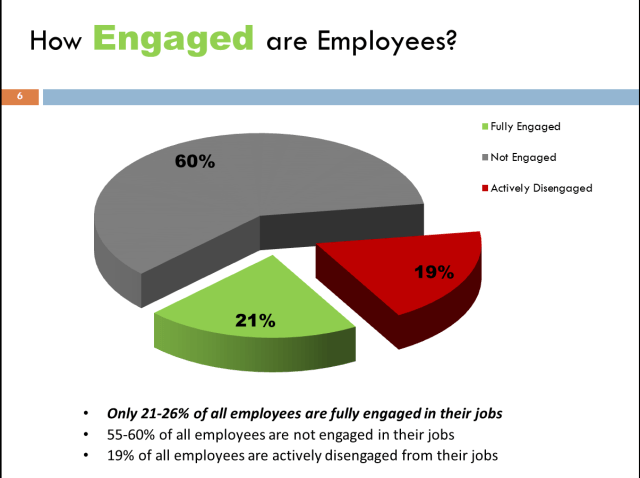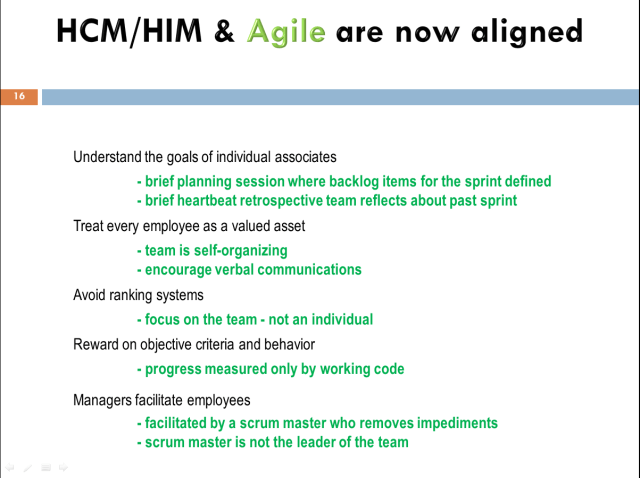By Brian Lucas
In the recent past, I was asked to address the subject of human capital management, the emergence of human interaction management and their effect on agile. The fact is that the people element in the system is most important and the process is often less than relevant. That makes human focused philosophies and agile a perfect match. Unfortunately, the more negative statistics about human involvement and commitment in the enterprise are difficult for some people to grasp or even believe. The lack of engagement in many enterprises is an amazing area of opportunity for improvement. I have not seen many good statistics that broadly measure the benefits agile brings when employee engagement is dramatically increased, but I know that impact is startling and a large contributor to agile’s success. So let’s take a look at agile and the human capital management concept.
How engaged are your employees? A Gallup Management Journal survey of 3,500 organizations reported in 2001 that only 26% of employees are fully engaged in their jobs while a 2007 Towers Perin report of over 90,000 employees showed that only 21% were engaged. This means that less than 1 in four employees are working to the goals of the company while three quarters of the work force was not actively or fully contributing to the organization bottom line. Only a fraction of your work force carries the load for the entire company and there is much room for performance, productivity and profitability improvement. Furthermore, a large percentage of the workforce is actively disengaged and working against the company goals. These toxic employees poison the work atmosphere for all those around them and even show a very negative face towards customers.
The bottom line is that not engaged and disengaged employees cost the organization huge amounts of money. They are far less productive, have no company loyalty, and spread suffering and chaos from increased financial volatility and negative financial cycles. All at a cost of $292-355 Billion dollars annually. Companies need to reengage their employee if they are to survive.
Human capital management systems can reengage your employees. In fact, investment in these systems is a leading rather than a lagging indicator of profits. Studies clearly indicate that companies with committed employees have significantly better employee performance. The financial data shows that these companies are significantly stronger financially even in challenging times. These companies typically deliver more than twice the shareholder value than their competitors according to a Gallup Management Journal Survey. “The corporation simply cannot afford to deprive itself of the intelligence, imagination and initiative of ninety per cent of the people who work for it, that is, the workers.“- Concept of the Corporation , Peter F. Drucker
 A focus on human performance management leads to profitability and sustainability. Over the last decade, companies that have invested in HCM systems have outperformed those who have not and weathered tough economic times better.
A focus on human performance management leads to profitability and sustainability. Over the last decade, companies that have invested in HCM systems have outperformed those who have not and weathered tough economic times better.
 Human interaction management not only focuses attention on the people element of the system, but seeks to optimize the activity by understanding patterns and behavior and encouraging innovation and collaboration. HIM embraces a Goal Oriented Organization Design concept which is amazingly similar to an agile team structure. Both are based on lattice organization structures that were first popularized by W.L. Gore.
Human interaction management not only focuses attention on the people element of the system, but seeks to optimize the activity by understanding patterns and behavior and encouraging innovation and collaboration. HIM embraces a Goal Oriented Organization Design concept which is amazingly similar to an agile team structure. Both are based on lattice organization structures that were first popularized by W.L. Gore.
HIM drives its activity from a three tiered strategy. From the top-down a set of Guide Points represent business strategy expressed as high-level models. Decisions however, are pushed down to the lowest level of empowerment with a middle-out approach. Finally, planning represents a collaborative work that evolves as an on-the-fly effort of the group during the normal execution of work in a bottom-up fashion.
Human Capital Management, Human Interaction Management and Agile are now very much in alignment. An individual associate’s goals are coordinated with the goals of short term efforts which advance both causes. The natural collaboration of an agile team and its self organization lend themselves to the treatment of employees as valued assets and ideas judged on merit. Ranking systems are an anathema to any well run organization or agile effort; in agile the focus is on the team. Rewards are made in both cases based on objective criteria; in agile that means working code – you can’t get much more objective than that. The final is one of the most important constructs: Managers facilitate employee creativity and productivity; they don’t order activity by fiat.
In summary, it is a changing world. Enterprises worried about productivity need to look to fully engaging their employees in the organizations vision. Human Interaction Management and Agile are not just buzzwords or fads they are evolved concepts designed to address short comings in management technique and organizational structure. Because we are in a Toffler third wave era demand for adaptability is progressing at an unrelenting pace. It is rapidly becoming a scenario reminiscent of the old west known as the quick and the dead.
Remember till next time, keep agile!








Brian,
Very comprehensive! What I love is that the basic common theme is derived from simple common sense. The entire world seems to have taken the focus off basic common sense and basic principles of business.
I see Agile as coming to our senses…
Just look at the general State of the Union. We are a mess because there is absolutely no common sense. Many of today’s businesses suffer from the same lack of basic understanding.
Thanks for your clarity.
David Francavilla
Dave,
Thank you for the comment and perception on agile as basic common sense. Since you are a natural agilist I am not at all surprised that you view agile in that fashion. In fact, I agree with you completely. We live in time of business insanity with self destructive actions taken by seemingly highly intelligent people. Unfortunately as Voltaire says, “Common sense is not so common.” and Will Rogers quips, “Common sense ain’t common.” René Descartes tells us “Common sense is the most widely shared commodity in the world, for every man is convinced that he is well supplied with it.”, he must have been having lunch with Will Rogers that day. Victor Hugo takes a stab at all the academics with, “Common sense is in spite of, not the result of, education.” My favorite quote on common sense however, comes from Harriet Beecher Stowe; and it is something I try to live by, “Common sense is seeing things as they are; and doing things as they ought to be.” In many ways that describes how you have approached life as well. I believe it should be our Mantra or Manifesto for “Natural” Agilists. -Brian
I am an H/R manager, could you post more on this or do you have a webinar link that you did? I really would appreciate any additional information or sources that you have. Barry
Barry – I gave this presentation several times, but it was never recorded. I will email you some sources of additional information along with my notes on this. -Brian
I agree Barry this is good stuff for business, but what I really like is how Brian has evolved the agile discussion here in his blog from software development, to people centricness, to oganization structures, to business thinking to being agile in ones personal life.
Could I get a copy of the PowerPoint presentation as well?
Brian,
This is the third post of yours I have read. I would say they keep getting better and better, but they were all exceptionally well written and had very solid content. I am so impressed with your blog; I cannot believe you are not promoting it more. I want to thank you for including your slides here in this post. They drive home the fact that I have seen as a consultant for the last 8 years that business as usual won’t do anymore. CEOs, of any company larger than 100, really need to have a moment of revelation and drop their hubris. They must realize that the way they have operated in the past is not working and the amount of employee dissatisfaction is a huge indicator of this. I have consulted with far too many CEOs who felt that more governance and oversight was the answer. These are the ones who just don’t get it and are doomed to fail. As the new economy continues to emerge they will lose all relevancy and last only as long as they capital assets, which are in some cases quite substantial, will keep them afloat. Thank you again for making my blog reading a very real pleasure!
Edward Smith
Business Consultant
Thanks Edward – It is always very rewarding for me to receive feedback from a fellow consultant. We literally live in a time of business organization revolution where the concepts of the past will be buried under an avalanche of new market environmental needs. -Brian
As the owner of a technology start-up I feel this is very important to me to get this right. I left the corporate world after 22 years of watching poor managers and even toxic ones destroy much of the productivity of a company and even good workers careers. This is an important subject that is vital to American business revitalization. You have put the facts here plainly and simply. It’s a very powerful message. WAKE UP CORPORATE AMERICA!
Indeed! Well said Bradley. Its past time for the clarion call.
Thank you for posting this Brian. It saved me a ton of work! I’ll be sure to pass the word around about how great your blog is!
Brian has really identified the CSF for agile it is people not process. I have worked as a tester in agile environments for 12 years and my early experience with companies that did not understand that fact was dreadful. When I finally got to work for a company that really understood human performance management is was such a pleasure to work, I looked forward to it every morning. The message here is you cannot do agile if your human resource management is screwed up. Thanks Brian for this presentation. -Jilly
Jilly – sorry I am so late in returning your comment, but I do appreciate you sharing your experience with us!
Thanks for the the PowerPoint slides Brian!
I agree with Jill entirely, if you do not have your organization human resources aligned to support empowerment and the flexibility demanded by agile, the benefits are minimal at best. Thanks for posting the slides Brian, very generous of you. -Mike
Cast your bread Mike!
Companies and managers that do not understand that human capital management will change drastically in an agile environment are doomed to fail.
The point here is that agile is by nature more reliant on human involvement and wholehearted commitment than other methods. That is something that I learned as a team leader though painful early attempts at agile.
Brian have you you noticed regional differences in how organizations treat HCM or international differences? Are some more advanced than others?
Brian would it be too much to ask if you could send me your PowerPoint presentation on this. I would be most grateful.
Pingback: Helen Brewster, Phd